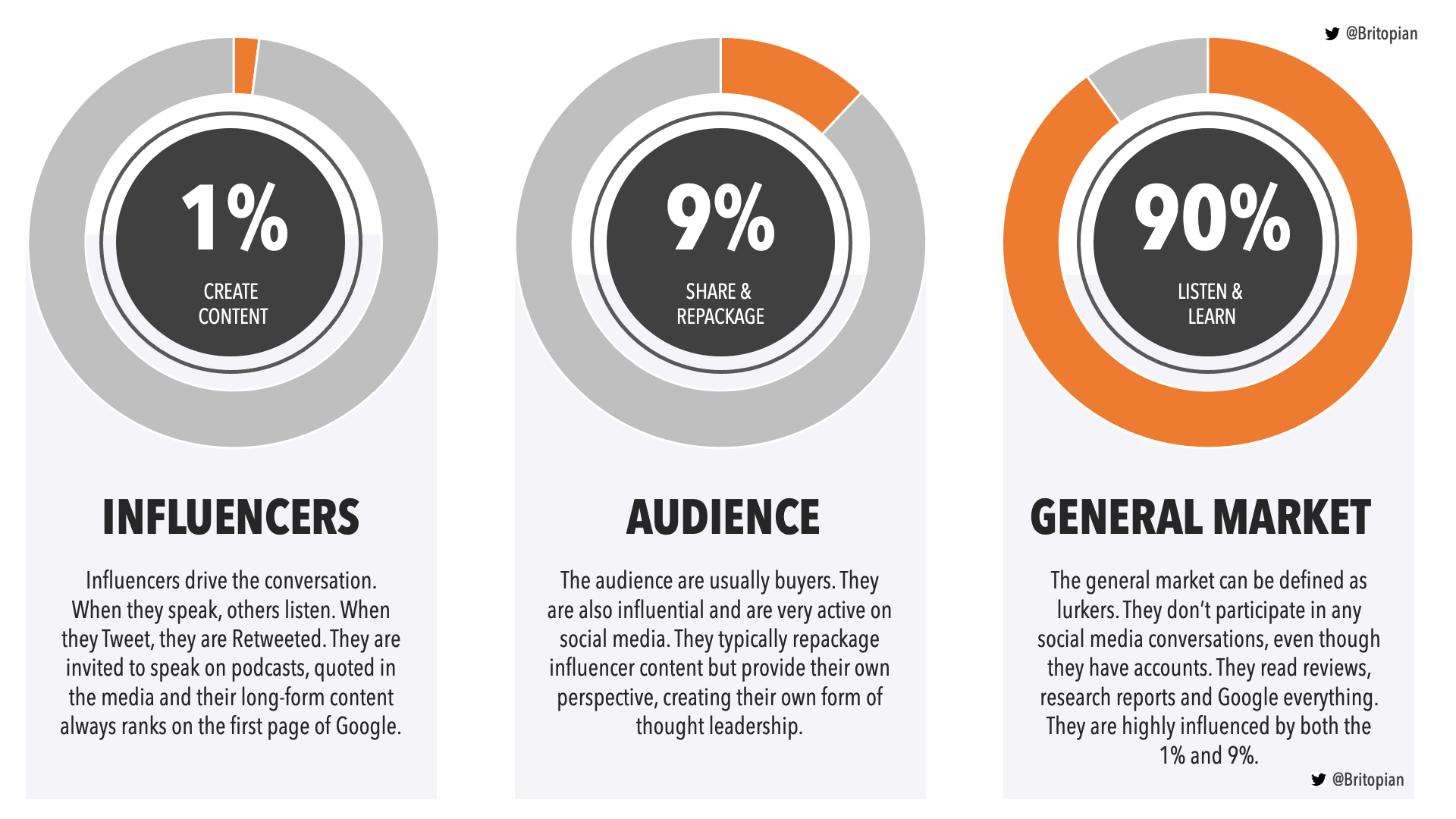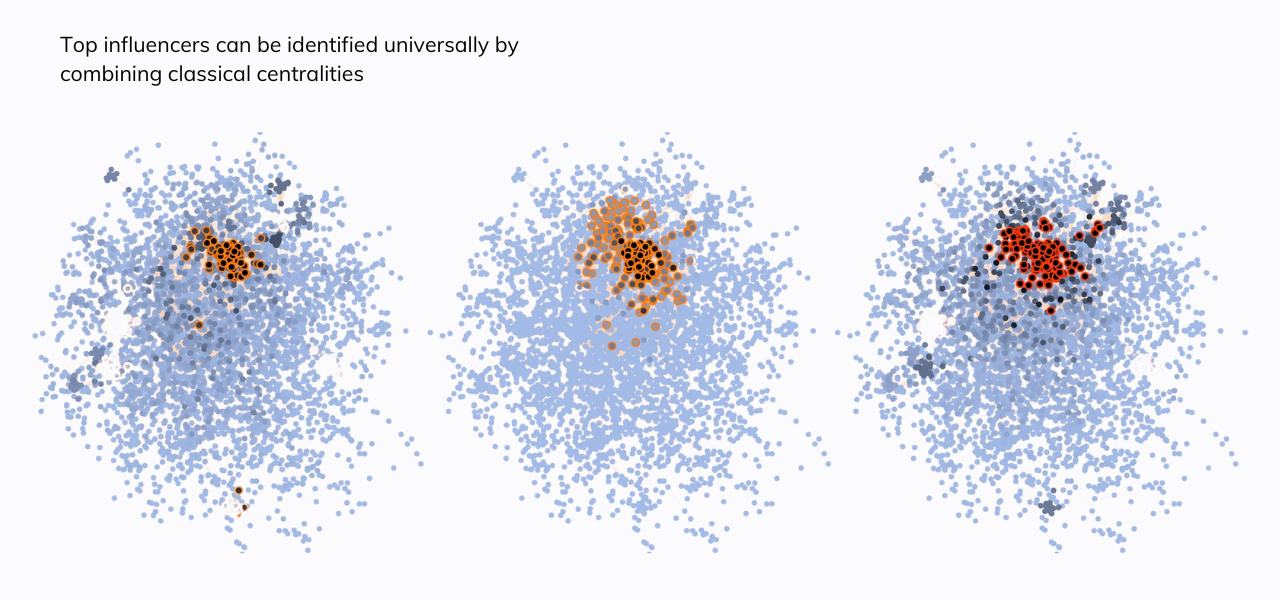Not all influencers are created equal. Using an influencer model to identify and segment the influencer community is a best practice.
Why this matters:
Understanding the 1:9:90 influencer model can help you collaborate with the most relevant and authoritative influencers.
In my experience, only one influencer model breaks down how influence is measured and segmented – the 1:9:90 model. This model was first coined by Charles Arthur in 2006, who observed that for every 100 individuals who create content online, only ten would engage with it, while the remaining 90 would simply view or read it. It is important to note that this model is distinct from the McKinsey Influence Model of 2016, which focuses on change management rather than influencer marketing.
What is an Influencer Model?
An influencer model is a sophisticated framework for dividing influencers into groups based on a certain method. This can be very helpful for reaching influencers with clear messages in the channels where they spend most of their time. But the process of researching and segmenting influencers involves a number of other important factors that must be taken into account.
When talking about any social influence model, it’s important to keep in mind the topic or market being talked about. For example, consumer influencer marketing programs tend to care less about the topics and more about the channels or platforms where influencers spend the most time. So, people often use phrases like “Instagram influencer,” “TikTok influencer,” and “Snapchat influencer.” But these influencer models are less useful for B2B companies because the enterprise sector cares more about the topics and thought leadership in which the influencers are experts and have authority.
The market or economy is also taken into account by the influencer model. There are many markets and submarkets, maybe even thousands. For example, some markets are geared toward pregnant women as customers, while others are geared toward men whose wives are about to give birth. There are markets for diapers, high-end homes, new cars, housing, and many other things.
But the markets for B2B and tech companies aren’t the same. This is where topic-based markets come in. These include the enterprise market, the SMB market, the data science market, the AI market, and the market for software.
The model of an influencer that we’re talking about today is based on these topics and markets. Still, it’s important to remember that in every market and subject, the top 1% of people are called “influencers,” the next 9% are called “promoters,” and the remaining 90% are called “lurkers.”
It’s important to understand the influencer model and its different parts if you want to target influencers and write messages that have an impact. Businesses can successfully use influencer marketing and get the desired results by considering the specific market or topic and the channels where influencers are most active.

Influencer Segmentation: The 1:9:90 Influencer Model
This influence model is broken down into 1%, 9%, and 90%. It should be noted that all individuals in the 1% and the 9% are influential. I would say that most people using social media are influential, but it depends on how you measure social media influence.
The 1%: Influencers
Back in the day, before the Internet, this was the media. And when I say the media, I mean the actual media companies and not necessarily the journalists who write the articles. Over time, journalists gained influence and still represent that top 1%.
But as the Internet has become more democratized and social media has allowed everyone to be a content creator, the top 1% in any market represents just that. Journalists, analysts, and anybody else with a point of view and the following online make up the 1%. Remember, this influencer marketing model is fluid. Just because one person is an influencer around digital transformation doesn’t mean they have the same influence on business and innovation.
When these influencers speak, people listen. When they write and publish, people share and engage. One thing to note here is that influencer content will always appear in the Google results, assuming they are influential in the topic or subject matter. Also, several influencer marketing platforms & reporting software tools that can track paid programs when engaging with the 1%.
The 9%: Promoters
The top 9% represented within the social influence model are called promoters. Don’t get me wrong; they are also influential. However, they don’t have as large audiences and are not driving any conversation or thought leadership.
Their behavior is fascinating. This group shares influencer content, but they repackage it differently and provide their context or take on the subject. I don’t negatively mean this. They’re not necessarily taking the credit for the thought leadership of the 1%; they provide their point of view on it.
The 90%: Lurkers
90% of this market are what I call lurkers. These people don’t necessarily participate in any social media conversations or behavior. They aren’t creating any content. They aren’t engaging or sharing content. All they do is scroll through their feeds and read. They use Google for everything, especially when researching a particular topic.
Regarding buying behavior or reputation, 90% rely heavily on the point of view of the 1% and the 9%.
Why This Influencer Model Works
For B2B social media marketing programs, influencers will be critical in reaching decision-makers within the buyer journey navigating the Internet and researching products and services. In addition, with influencer segmentation, marketers can create custom programming tailored to the 1%, 9%, and 90%.
For example, let’s assume you analyzed and found the top AI influencers. Part of your program will entail collaborating with them and paying them to participate in a campaign. This includes blog posts, interviews with executives, or social media promotion. The goal is to tap into their authority and audience because they are the 1% and typically have a large following.
In that same analysis, you may have identified the 9% as a more significant influencer segment because there are more. In this case, you will listen to their conversations in real time and create content based on what is trending. You may not contact them directly or partner with them for some paid activation, but your organic engagement will be enough.
And then 90% of that audience could be used just for essential social listening or understanding more significant trends in consumption of the 1% in the 9%.
In other words, how you reach and engage the 90% is not the same way you would reach and engage the 1%. So I think if you target the 1% and the 9% with specific marketing programs, you won’t have to worry about everyone else because the influencers and promoters will do your job for you.
Other Influencer Models
In addition to the model above, you can use several other influencer models to reach new audiences. Two models that stand out are the network centrality model and the content creator model.
The main goal of the network centrality model is to find influencers based on the centrality or position of their network within the network. According to this model, people in the middle of a network have more power and reach than those on the edges. The network centrality model is especially useful for finding B2B influencers, where networking and relationships are key to decision-making.

The content creator model finds influencers based on their ability to make high-quality, interesting content that connects with their audience. In this model, influencers are judged based on how well they can create and share content. If you want to make high-quality, interesting content, you can use the content creator model to find influencers whose content skills fit with its marketing goals.
Both the network centrality model and the content creator model have their advantages and disadvantages. But combining the two models can lead to the best results by finding influencers who are both well-connected and good at making content. Understanding and using these models of influencers can help you make smart decisions and successfully navigate the complex world of influencer marketing.
Related Content
